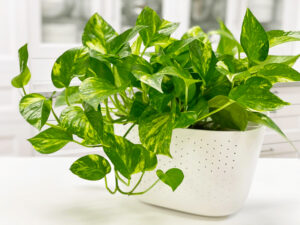How to grow and care pothos Complete Guide
Popular houseplant pothos (Epipremnum aureum) is renowned for its resilient nature and eye-catching heart-shaped leaves. Known as “devil’s ivy,” this tropical vine is a great option for both inexperienced and seasoned gardeners because it is low maintenance and adaptable to a variety of environments. Everything you need to know to grow pothos successfully will be covered in this tutorial, from choosing the best pot to providing the best possible care.
1. Selecting the Proper Pot and Soil Pot:
Material: Pothos grow well in a variety of containers made of terracotta, ceramic, and plastic. Terracotta allows for better aeration whereas plastic stores moisture more effectively.
Drainage: To avoid waterlogging, which can result in root rot, make sure your pot includes drainage holes.
Soil:
Make sure the potting mix drains well. A mixture made specifically for houseplants or a combination of vermiculite, perlite, and peat is effective. This ensures optimal moisture retention while enabling excess water to escape.
2. Minimal Conditions
Pothos is a versatile plant that can thrive in a range of lighting situations.
Low Light: Because they do well in low light, they are ideal for gloomy workplaces and corners. But in really low light, growth can slow.
The best kind of light for optimal growth is indirect, bright light. Your pothos should be placed next to a window that lets in filtered sunlight.
Steer clear of direct sunlight: This can scorch the leaves, causing brown tips and a duller look.
3. Taking Care of Your Plants
Watering is essential to keeping your pothos healthy:
Water when it feels like the top inch of soil is dry. Depending on your surroundings, this could occur every one to two weeks.
Method: Fill with water and let it run off the bottom. This guarantees that moisture reaches every part of the root system.
Overwatering Indications: Overwatering might be indicated by withering, mushy stems, or yellowing foliage.
Indications of Submersion: A generally drooping appearance combined with crispy, dry leaves indicates that your plant needs water.
4. Humidity and Temperature
Pothos likes warm surroundings:
The optimal temperature range is 60°F to 85°F (15°C to 29°C). Keep your pothos away from heating vents and chilly drafts.
Pothos are tolerant of low humidity, however they prefer higher humidity ranges (40–60%). Consider using a humidifier or periodically spraying the plant if your house is dry.
5. Fertilizing
Regular fertilization is essential to maintaining the health and growth of your pothos:
Apply a well-balanced, water-soluble fertilizer such as a 20-20-20 blend. Fish emulsion and compost tea are examples of organic alternatives that can also be successful.
Frequency: During the growing season (spring and summer), fertilize every 4-6 weeks. When growth slows in the fall and winter, reduce or stop fertilizing.
6. Pruning and Propagation
Pruning promotes new growth and keeps a bushy appearance:
When to Prune: The best time to prune is in the early spring. To encourage bushiness, remove any dead or yellowing leaves and clip back long vines.
Transmission: Pothos is simple to multiply via cuttings:
Take a cutting that has two or more nodes, or the little bumps where leaves come out.
The cutting can be buried in soil or submerged in water.
Until roots develop, if using water, change it every several days (approximately 2-4 weeks). After rooted, place in soil.
7. Pest Management
Despite its general resistance to pests, pothos can occasionally draw them in:
Common Pests: Watch out for mealybugs, aphids, and spider mites.
Treatment: Use insecticidal soap or neem oil for more severe infestations, or wipe away pests from leaves using a moist cloth. Checking your plant frequently can assist in identifying issues early on.
8. Repotting
Your pothos may overrun its pot as it grows:
When to Repot: If roots are emerging from the drainage holes, you should repot every one to two years.
Method for Repotting:
Select a pot that is one to two inches bigger around.
With extreme caution to avoid damaging the roots, carefully take the plant out of its old pot.
Make sure the root ball is the same depth as before and place it in the newly filled container.
9. Common Issues and Solutions
Yellowing Leaves: This may be a sign of inadequate drainage or overwatering. Verify the moisture content of the soil and modify your watering plan.
Leggy Growth: Your pothos could not be getting enough light if it is reaching for the light. Take it somewhere with more light.
Brown Leaf Tips: This may indicate infrequent or low humidity irrigation. Raise the humidity or examine your watering schedule.

10. Using Pothos to decorate
Pothos can improve your home environment:
Hanging Planters: Their trailing tendrils in hanging pots make a beautiful sight.
Organize them on shelves so the vines can saunter down them.
Mixed Arrangements: To create a lush, green show, combine pothos with other indoor plants.
In summary
Pothos is a lovely, tolerant plant that adds brightness to any area. These tips—appropriate light, watering, fertilization, and maintenance—will help you have a healthy pothos plant for many years to come. This resilient vine will look great whether you use it as a decorative accent or to clean the air. Happy gardening!


